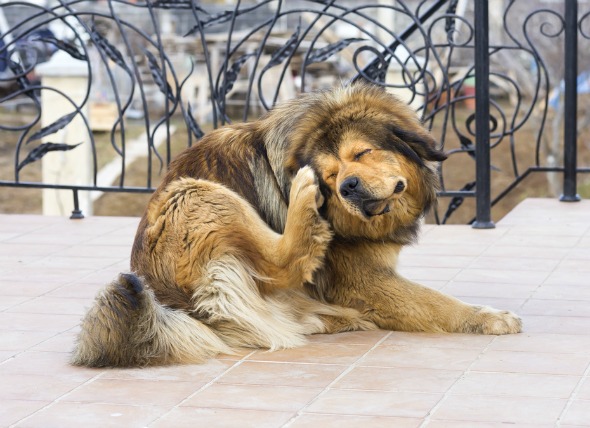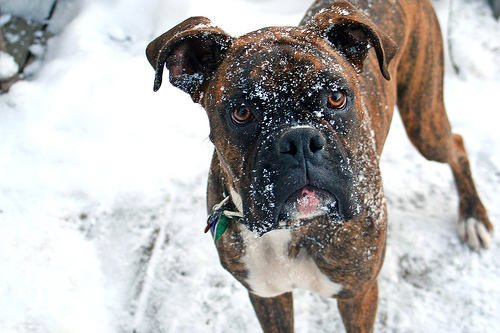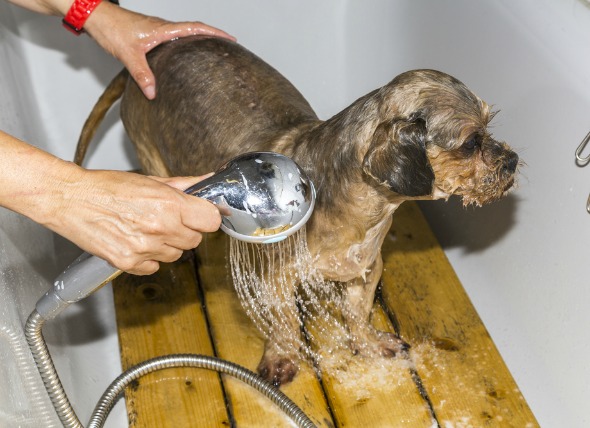

When pet owners are asked what they dread most about the summer months, the topic that invariably comes up most is fleas!
Fleas on dogs and cats! These small dark brown insects prefer temperatures of 65-80 degrees and humidity levels of 75-85 percent -- so for some areas of the country they are more than just a "summer" problem.
Dogs and cats often get infested with fleas through contact with other animals or contact with fleas in the environment. The strong back legs of this insect enable it to jump from host to host or from the environment onto the host. (Fleas do not have wings, so they cannot fly!) The flea’s bite can cause itching for the host but for a sensitive or flea-allergic animal, this itching can be quite severe and leads to hair-loss, inflammation and secondary skin infections. Some pets, hypersensitive to the flea's saliva, will itch all over from the bite of even a single flea!
The flea information presented here will focus on treatment for and prevention of fleas, which, let’s face it, is just as important to the pet as it is to the pet's caretakers!
How do you know if fleas are causing all that itching – formally known as pruritus? Generally, unlike the burrowing, microscopic Demodex or Scabies Mites, fleas can be seen scurrying along the surface of the skin. Dark copper colored and about the size of the head of a pin, fleas dislike light so looking for them within furry areas and on the pet's belly and inner thighs will provide your best chances of spotting them.
Look for "flea dirt", too. "Flea dirt" looks like dark specks of pepper scattered on the skin surface. If you see flea dirt, which is actually flea feces and is composed of digested blood, pick some off the pet and place on a wet paper towel. If after a few minutes the tiny specks spread out like a small blood stain, it's definitely flea dirt and your pet has fleas!
In order to understand how and why treatment options work, we must first understand the flea’s life cycle since the various modern treatment and prevention products work on different parts of this life cycle. There are several stages to its life cycle: egg, larva or caterpillar, pupa or cocoon, and adult. The length of time it takes to complete this cycle varies depending upon the environmental conditions such as temperature, humidity, and the availability of a nourishing host.
The flea's host is a warm-blooded animal such as a dog or cat (or even humans!) However, the various flea stages are quite resistant to freezing temperatures. The adult female flea typically lives for several weeks on the pet. During this time period she will suck the animal’s blood two to three times and lay twenty to thirty eggs each day. She may lay several hundred eggs over her life span. These eggs fall off of the pet into the yard, bedding, carpet, and wherever else the animal spends time.
These eggs then proceed to develop where they have landed. Since they are about 1/12 the size of the adult, they can even develop in small cracks in the floor and between crevices in carpeting. The egg then hatches into larvae. These tiny worm-like larvae live among the carpet fibers, in cracks of the floor, and outside in the environment. They feed on organic matter, skin scales, and even the blood-rich adult flea feces.
The larvae grow, molt twice and then form a cocoon and pupate, waiting for the right time to hatch into an adult. These pupae are very resilient and are protected by their cocoon. They can survive quite a long time, waiting until environmental conditions and host availability are just right. Then they emerge from their cocoons when they detect heat, vibrations and exhaled carbon dioxide, all of which indicate that a host is nearby. The newly emerged adult flea can jump onto a nearby host immediately.
Under optimal conditions, the flea can complete its entire life cycle in just fourteen days. Just think of the tens of thousands of the little rascals that could result when conditions are optimal!
Knowing this life cycle allows us to understand why it has always been important to treat both the host animal and the indoor and outdoor environment in order to fully control flea numbers. Simply sprinkling some flea powder on your pet will not work; simply vacuuming the home vigorously will not work, simply placing a flea collar or using a flea topical on your pet will not work.
There are a wide variety of flea products on the market today, but the newer prescription products are finally taking the frustration out of flea control with popular and highly effective brands. In some cases it is even possible to gain control by treating only the pet. Some of these flea products do not harm the adult flea but instead prevents her eggs from hatching, thus breaking the life cycle of the flea; with no reproduction the flea population eventually dissipates as long as the pet isn't coming in contact with new fleas continually.
In warm climates, this treatment is typically year round, but in other climates treatment should begin in early spring before the flea season starts. In addition, these type of products are not a good choice for animals that are allergic to flea saliva (have flea bite hypersensitivity) since the adult fleas are not killed and are still able to bite the animal.
There are also many other products which will kill fleas on the pet and for which no prescription is needed. The drawback, however, is that some of these products may be less effective than the prescription products, but many really do help control flea populations. These non-prescription flea products include flea shampoos, flea powders, flea sprays, flea collars and spot-on products. There are even natural flea control products available, too!
With any flea treatment it is necessary to treat all of the animals in the home in order to achieve complete success. In addition, you will likely need to treat the indoor and outdoor environment. When treating the indoor environment it is important to wash all bedding in soapy, hot water especially if the pets spend time on your bed. All of the carpeting should be vacuumed thoroughly and the vacuum bag thrown away. Steam cleaning the carpet can kill some of the larvae as well. Remember, though, that vacuuming and shampooing a carpet will still leave a good percentage of live fleas so some sort of chemical treatment may be necessary.
The entire house is now ready to treat. Several choices are available including highly effective foggers. The most effective products are those which contain both an ingredient to kill adult fleas and an ingredient to kill the other life cycle stages. The latter is called an insect growth regulator.
Methoprene is one such growth regulator. Aerosol foggers may not penetrate well enough, in some cases, to kill all the hiding fleas and larvae. Another option for indoor control is a sodium borate product that is applied to carpeting. You should consider calling a local exterminating company for an estimate and a guarantee that their procedure will rid your premises of fleas.
Flea eradication won't be cheap, either, but what price will you put on living free from flea infestations?
As for outdoor control, sprays and pelleted insecticides are generally used after dog houses and kennels are cleaned thoroughly. An insect growth regulator is a good choice here as well. Pyriproxifen, is more stable in sunlight and lasts longer outdoors than Methoprene.
It is important to know that the Environmental Protection Agency (EPA) has banned the insecticide Chlorpyrifos (Dursban). Production ceased in December of 2000.
Certain non-toxic nematodes (tiny worms) can also be spread in areas of the yard which are warm and moist and which pets and fleas frequent. The nematodes feed on the flea larvae. And once there is a cover of snow on the ground, much of the major source of fleas is eliminated.
Be sure to consult your veterinarian regarding which methods and products will be best for you and your pets. Your veterinarian will be your best source for current flea information. It's a battle, so... good luck and happy flea control!
 How to Become a Dog Trainer
10 Quick Tips to Becoming a Professional Dog Trainer
&nbs
How to Become a Dog Trainer
10 Quick Tips to Becoming a Professional Dog Trainer
&nbs
 Principles of Dog Nutrition
By T. J. Dunn, Jr., DVM
Pet nutriti
Principles of Dog Nutrition
By T. J. Dunn, Jr., DVM
Pet nutriti
 Heartworm Disease in Dogs
Heartworms in Dogs
By T. J. Dunn, Jr., DVM
Heartworm Disease in Dogs
Heartworms in Dogs
By T. J. Dunn, Jr., DVM
 8 Tips For Caring For Your Pet This Winter
Living in a Winter Wonderland?
Unless you&
8 Tips For Caring For Your Pet This Winter
Living in a Winter Wonderland?
Unless you&
 'Natural' Methods for Controlling Fleas in Dogs
By Jennifer Kvamme, DVM
While there are a m
'Natural' Methods for Controlling Fleas in Dogs
By Jennifer Kvamme, DVM
While there are a m
Copyright © 2005-2016 Pet Information All Rights Reserved
Contact us: www162date@outlook.com